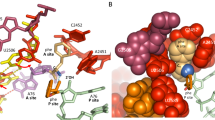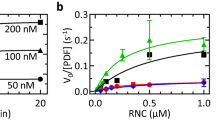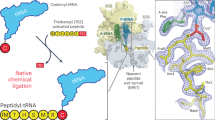Abstract
Despite protein biosynthesis being studied for decades, some major questions concerning this process are still to be addressed. We elucidate a close connection between proofreading of the emerging amino acid sequence during its normal, elongation factor-dependent ribosomal biosynthesis and the existence of the factor-free synthesis of a polypeptide chain on a ribosome. In this factor-free process, the biological role of proofreading is played by a process opposite to the factor-free attachment of Aa-tRNA to the ribosome, namely, the removal via the same pathway of that Aa-tRNA, which is not complementary to the mRNA codon exhibited by the ribosome.



Similar content being viewed by others
REFERENCES
Fersht A. 2017. Structure and Mechanism in Protein Science: A Guide to Enzyme Catalysis and Protein Folding. New Jersey: World Scientific.
Spirin A.S. 1999. Ribosomes. New York: Kluwer.
Moras D. 2010. Proofreading in translation: Dynamics of the double–sieve model. Proc. Natl. Acad. Sci. U. S. A. 107, 21949‒21950.
Hussain T., Kamarthapu V., Kruparani S.P., Desh-mukh M.V., Sankaranarayanan R. 2010. Mechanistic insights into cognate substrate discrimination during proofreading in translation. Proc. Natl. Acad. Sci. U. S. A. 107, 22117‒22121.
Hopfield J.J. 1974. Kinetic proofreading: a new mechanism for reducing errors in biosynthetic processes requiring high specificity. Proc. Natl. Acad. Sci. U. S. A. 71, 4135‒4139.
Leong K.-W., Uzun Ü., Selmer M., Ehrenberg M. 2016. Two proofreading steps amplify the accuracy of genetic code translation. Proc. Natl. Acad. Sci. U. S. A. 113, 13744‒13749.
Pestka S. 1968. Studies on the formation of transfer ribonucleic acid–ribosome complexes: 3. The formation of peptide bonds by ribosomes in the absence of supernatant enzymes. J. Biol. Chem. 243, 2810‒2820.
Pestka S. 1969. Studies on the formation of transfer ribonucleic acid–ribosome complexes: 4. Oligopeptide synthesis and translocation on ribosomes in the presence and absence of soluble transfer factors. J. Biol. Chem. 244, 1533‒1539.
Gavrilova L.P., Smolyaninov V.V. 1971. Study of the mechanism of translocation in ribosomes: 1. Polyphenylalanine synthesis in Escherichia coli ribosomes without participation of guanosine-5'-triphosphate and protein translation factors. Mol. Biol. (Moscow). 5 (6), 710–717.
Gavrilova L.P., Spirin A.S. 1971. Stimulation of “non-enzymic” translocation in ribosomes by ρ-chloromercuribenzoate. FEBS Lett. 17, 324‒326.
Lucas-Lenard J., Lipmann F. 1971. Protein biosynthesis. Annu. Rev. Biochem. 40, 409‒448.
Gavrilova L.P., Spirin A.S. 1972. A modification of the 30S ribosomal subparticle is responsible for stimulation of “non-enzymatic” translocation by p-chloromercuribenzoate. FEBS Lett. 22, 91‒92.
Gavrilova L.P., Rutkevitch N.M. 1980. Ribosomal synthesis of polyleucine on polyuridylic acid as a template: Contribution of the elongation factors. FEBS Lett. 120, 135‒140
Gavrilova L.P., Perminova I.N., Spirin A.S. 1981. Elongation factor Tu can reduce translation errors in poly(U)-directed cell-free systems. J. Mol. Biol. 149, 69‒78.
Noel J.K., Whitford P.C. 2016. How EF-Tu can contribute to efficient proofreading of aa-tRNA by the ribosome. Nat. Commun. 7, 13314.
Gavrilova L.P., Kakhniashvili D.G., Smailov S.K. 1984. Stoichiometry of GTP hydrolysis in a poly(U)-dependent cell-free translation system. Determination of GTP/peptide bond ratios during codon-specific elongation and misreading. FEBS Lett. 178, 283‒287.
Kakhniashvili D.G., Smailov S.K., Gavrilova L.P. 1986. The excess GTP hydrolyzed during mistranslation is expended at the stage of EF-Tu-promoted binding of non-cognate aminoacyl-tRNA. FEBS Lett. 196, 103‒107.
Author information
Authors and Affiliations
Corresponding author
Additional information
Translated by M. Batrukova
Rights and permissions
About this article
Cite this article
Finkelstein, A.V., Gavrilova, L.P. Protein Biosynthesis Proofreading Is Closely Associated with the Existence of Factor-Free Ribosomal Synthesis. Mol Biol 53, 308–311 (2019). https://doi.org/10.1134/S0026893319020043
Received:
Revised:
Accepted:
Published:
Issue Date:
DOI: https://doi.org/10.1134/S0026893319020043




